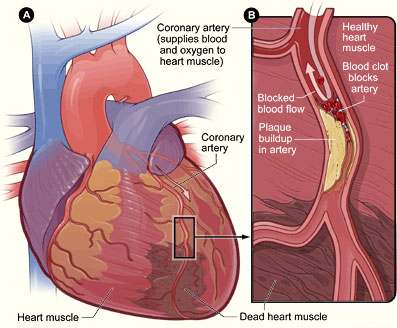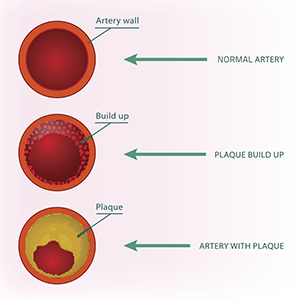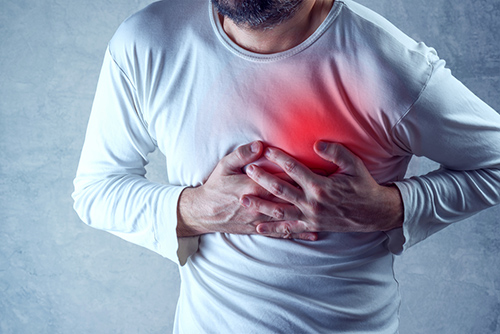Learn
Heart Attack
A heart attack (also called a myocardial infarction or MI) occurs when the heart muscle (or myocardium) itself does not receive enough oxygen-rich blood. This can happen when any of the coronary vessels carrying blood to the heart muscle become blocked. The muscle below the blockage will die and stop functioning.

Image 1 Coronary Artery Disease
In Image 1 above, Image A shows a blocked coronary artery. The dead myocardium is just below the blocked artery. There is decreased flow of oxygen-rich blood.
Image B illustrates the cholesterol build-up, or plaque, within the vessel lining, causing narrowing of the artery lumen, and it is completely blocked with a blood clot formation.
This diagram shows plaque build up.

Excess circulating fats in the blood stream can build up between the walls of a coronary artery. These buildups are referred to as fatty streaks or plaques. If the plaques become large enough, they can push out into the coronary artery itself, creating a blood clot or blockage and possibly a heart attack.
Watch the video How A Heart Attack Occurs (0:37) to see a 3-D animation that shows how plaques form in a blood vessel, leading to blockage and a heart attack.
Open How a Heart Attack Occurs in a new tab | Open How a Heart Attack Occurs Video Transcript in a new tab
![]() Check your understanding...
Check your understanding...
When plaque within the lining of a coronary artery ruptures, what is formed and what is the ending result?
Answer: A clot that creates complete blockage of blood flow resulting in heart attack
A myocardial infarction is another term for a _______________.
Answer: heart attack
Go to "Watch, Learn, and Live: The Heart" the animation illustrating the process leading to a heart attack.
A Heart Attack occurs when _____________.
Answer: The blood flow that brings oxygen to the heart muscle is severely reduced or stopped.
Symptoms of a Heart Attack
What are symptons of a heart attack?
- Chest pain or discomfort
- Shortness of Breath
- Nausea and Vomiting
- Cold Sweat
- Unusual Fatigue
- Dizziness
See "NIH: What are the Symptoms of a Heart Attack" for more about these symptoms.

